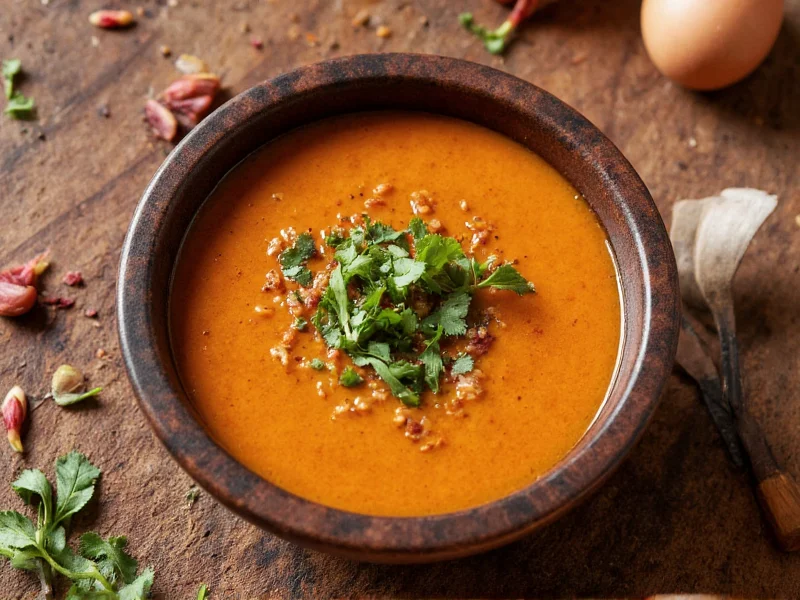Moroccan cuisine offers some of the world's most aromatic and complex soups, with Harira standing as the undisputed national favorite. This traditional Moroccan soup represents centuries of culinary tradition blending Berber, Arab, and Mediterranean influences into one nourishing bowl. Understanding authentic Moroccan soup preparation requires appreciating both the ingredients and cultural context that make these dishes special.
The Cultural Significance of Moroccan Soup
In Morocco, soup isn't merely food—it's woven into the social and religious fabric of daily life. Families traditionally gather around steaming bowls of Harira during Ramadan to break their fast, while simpler lentil or vegetable soups appear in weekday meals across the country. The Friday tradition of serving Harira connects communities through shared culinary heritage, with each region adding distinctive touches while maintaining core elements that define authentic Moroccan soup.
Key Varieties of Traditional Moroccan Soup
While Harira reigns supreme, Moroccan culinary tradition features several distinctive soup varieties:
- Harira - The national soup, typically made with tomatoes, lentils, chickpeas, meat, and spices
- Bissara - A simple fava bean soup often served for breakfast
- Z'houl - A regional fish soup from coastal areas
- Chorba - A lighter broth-based soup with herbs and vegetables
| Essential Moroccan Soup Ingredient | Traditional Purpose | Substitution Options |
|---|---|---|
| Argan oil | Finishing touch adding nutty flavor | Olive oil (less traditional) |
| Cinnamon | Warm base note in spice blend | None (essential) |
| Fenugreek | Distinctive earthy flavor | Mustard powder (partial substitute) |
| Cilantro & Parsley | Fresh herb base | None (critical for authenticity) |
| Verjuice or lemon | Acidity balance | Vinegar (less traditional) |
Authentic Moroccan Harira Recipe
Creating traditional Moroccan Harira requires patience and attention to ingredient quality. The best versions develop flavor through multiple cooking stages rather than quick preparation. Authentic Moroccan lentil soup and chickpea variations follow similar preparation methods with ingredient adjustments.
Traditional Ingredients
For an authentic Moroccan tomato soup base, you'll need:
- 2 cups cooked chickpeas (reserve liquid)
- 1½ cups brown or green lentils
- 1 lb lamb or beef, cut into small cubes
- 2 large onions, finely chopped
- 4 ripe tomatoes, grated or high-quality canned
- ½ cup fresh cilantro, finely chopped
- ½ cup fresh parsley, finely chopped
- 2 tbsp tomato paste
- 1 tsp ground ginger
- 1 tsp turmeric
- ½ tsp saffron threads
- 1 cinnamon stick
- Flour for thickening
- Lemon wedges for serving
Step-by-Step Preparation
Authentic Moroccan soup preparation follows these essential steps:
- Sauté onions in olive oil until golden
- Add meat and brown on all sides
- Stir in spices and tomato paste, cooking for 2 minutes
- Add tomatoes, lentils, and enough water to cover
- Simmer for 45 minutes until meat is tender
- Add chickpeas and continue simmering 20 minutes
- Prepare flour slurry (2 tbsp flour + ½ cup reserved chickpea liquid)
- Slowly incorporate slurry while stirring constantly
- Add fresh herbs and simmer 15 more minutes
- Adjust seasoning and serve with lemon wedges
Regional Variations Across Morocco
Traditional Moroccan soup recipes vary significantly by region. In Fes, Harira often includes more meat and saffron, while coastal versions incorporate seafood. Southern regions might add dried fruits for sweetness, and mountain areas use heartier grains. Understanding these regional differences helps create authentic Moroccan chickpea soup or lentil variations that honor local traditions.
Serving Traditions and Accompaniments
Moroccans traditionally serve Harira with dates to break the Ramadan fast, followed by other courses. For everyday meals, it's commonly accompanied by msemen (Moroccan pancakes) or khobz (traditional bread). The soup's consistency should be thick enough to coat a spoon but still pourable—a hallmark of properly prepared Moroccan soup.
Nutritional Benefits of Moroccan Soup
Authentic Moroccan soup offers impressive nutritional value. The combination of legumes, vegetables, and lean meats creates a balanced meal rich in protein, fiber, and complex carbohydrates. Traditional preparation methods preserve nutrients while making them more bioavailable. Many Moroccan soup ingredients contain anti-inflammatory compounds from the distinctive spice blends that have been part of North African culinary tradition for centuries.
Common Mistakes to Avoid
When preparing traditional Moroccan soup, avoid these common pitfalls:
- Rushing the cooking process—authentic flavor develops through slow simmering
- Using pre-ground spices instead of freshly grinding them
- Adding lemon too early, which can cause tomatoes to become bitter
- Over-thickening the soup beyond traditional consistency
- Omitting fresh cilantro and parsley, which provide essential flavor notes
Adapting Moroccan Soup for Modern Kitchens
While traditional preparation takes hours, modern cooks can achieve authentic Moroccan soup flavors with some adjustments. Using high-quality canned tomatoes, pre-cooked lentils, and proper spice ratios can yield excellent results in less time. For vegan Moroccan soup options, simply omit meat and use vegetable broth while maintaining the essential spice profile that defines authentic preparation.











 浙公网安备
33010002000092号
浙公网安备
33010002000092号 浙B2-20120091-4
浙B2-20120091-4